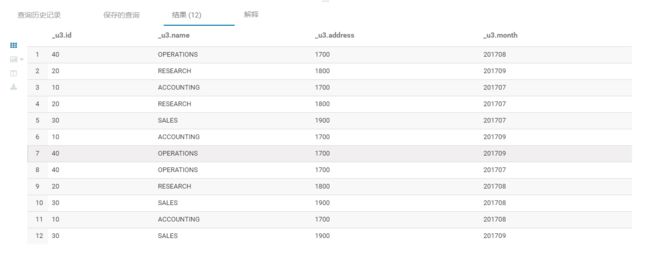Hive学习笔记-第九章 分区表和分桶表
1分区表
分区表实际上就是对应一个HDFS文件系统上的独立的文件夹,该文件夹下是该分区所有的数据文件。Hive中的分区就是分目录,把一个大的数据集根据业务需要分割成小的数据集。在查询时通过 WHERE 子句中的表达式选择查询所需要的指定的分区,这样的查询效率会提高很多。
1.1 分区表的基本操作
(1)引入分区表(需要根据日期对日志进行管理)
/user/hive/warehouse/log_partition/20170702/20170702.log
/user/hive/warehouse/log_partition/20170703/20170703.log
/user/hive/warehouse/log_partition/20170704/20170704.log
(2)创建分区表语法
create table dept_partition(id int, name string, address string)
partitioned by (month string)
row format delimited fields terminated by '\t';
注意:分区字段不能是表中已经存在的数据,可以将分区字段看作表的伪列。
(3)加载数据到分区表中
load data inpath '/mario/hive/dept_partition/dept.txt' into table dept_partition partition(month='201709');
load data inpath '/mario/hive/dept_partition/dept.txt' into table dept_partition partition(month='201708');
load data inpath '/mario/hive/dept_partition/dept.txt' into table dept_partition partition(month='201707');
注意:分区表加载数据时,必须指定分区
(4)查询分区表中数据
单分区查询
select * from dept_partition where month='201709';
多分区联合查询
select * from dept_partition where month='201709' union
select * from dept_partition where month='201708'union
select * from dept_partition where month='201707';
(5)增加分区
创建单个分区
alter table dept_partition add partition(month='201706') ;
同时创建多个分区
alter table dept_partition add partition(month='201705') partition(month='201704');
(6)删除分区
删除单个分区
alter table dept_partition drop partition (month='201704');
同时删除多个分区
alter table dept_partition drop partition (month='201705'), partition (month='201706');
(7)查看分区表有多少分区
show partitions dept_partition;
(8)查看分区表结构
desc formatted dept_partition;
1.2分区表注意事项
(1)创建二级分区表
create table dept_partition2(deptno int, dname string, loc string)
partitioned by (month string, day string)
row format delimited fields terminated by '\t';
(2)正常的加载数据
加载数据到二级分区表中
load data inpath '/mario/hive/dept_partition/dept.txt' into table
dept_partition2 partition(month='201709', day='13');
查询分区数据
select * from dept_partition2 where month='201709' and day='13';
(3)把数据直接上传到分区目录上,让分区表和数据产生关联的三种方式
方式一:上传数据后修复
- 上传数据
hdfs dfs -mkdir -p /user/hive/warehouse/dept_partition2/month=201709/day=12;
hdfs dfs -put /opt/module/datas/dept.txt /user/hive/warehouse/dept_partition2/month=201709/day=12;
- 查询数据(查询不到刚上传的数据)
select * from dept_partition2 where month='201709' and day='12';
- 执行修复命令
msck repair table dept_partition2;
- 再次查询数据
select * from dept_partition2 where month='201709' and day='12';
方式二:上传数据后添加分区
- 上传数据
hdfs dfs -mkdir -p /user/hive/warehouse/dept_partition2/month=201709/day=11;
hdfs dfs -put /opt/module/datas/dept.txt /user/hive/warehouse/dept_partition2/month=201709/day=11;
- 执行添加分区
alter table dept_partition2 add partition(month='201709', day='11');
- 查询数据
select * from dept_partition2 where month='201709' and day='11';
方式三:创建文件夹后load数据到分区
- 创建目录
hdfs dfs -mkdir -p /user/hive/warehouse/dept_partition2/month=201709/day=10;
- 上传数据
load data inpath '/mario/hive/dept_partition/dept.txt' into table dept_partition2 partition(month='201709',day='10');
- 查询数据
select * from dept_partition2 where month='201709' and day='10';
1.3 动态分区调整
关系型数据库中,对分区表Insert数据时候,数据库自动会根据分区字段的值,将数据插入到相应的分区中,Hive中也提供了类似的机制,即动态分区(Dynamic Partition),只不过,使用Hive的动态分区,需要进行相应的配置。
开启动态分区参数设置
(1)开启动态分区功能(默认true,开启)
hive.exec.dynamic.partition=true
(2)设置为非严格模式(动态分区的模式,默认strict,表示必须指定至少一个分区为静态分区,nonstrict模式表示允许所有的分区字段都可以使用动态分区。)
hive.exec.dynamic.partition.mode=nonstrict
(3)在所有执行MR的节点上,最大一共可以创建多少个动态分区。默认1000
hive.exec.max.dynamic.partitions=1000
(4)在每个执行MR的节点上,最大可以创建多少个动态分区。该参数需要根据实际的数据来设定。比如:源数据中包含了一年的数据,即day字段有365个值,那么该参数就需要设置成大于365,如果使用默认值100,则会报错。
hive.exec.max.dynamic.partitions.pernode=100
(5)整个MR Job中,最大可以创建多少个HDFS文件。默认100000
hive.exec.max.created.files=100000
(6)当有空分区生成时,是否抛出异常。一般不需要设置。默认false
hive.error.on.empty.partition=false
案例实操:
(1)需求:将dept表中的数据按照地区(loc字段),插入到目标表dept_partition的相应分区中。
(2)创建目标分区表
create table dept_partition(id int, name string)
partitioned by (location int)
row format delimited fields terminated by '\t';
(3)设置动态分区
set hive.exec.dynamic.partition.mode = nonstrict;
insert into table dept_partition
partition(location) select deptno, dname, loc from dept;
(4)查看目标分区表的分区情况
show partitions dept_partition;
思考:目标分区表是如何匹配到分区字段的?
2.分桶表
分区提供一个隔离数据和优化查询的便利方式。不过,并非所有的数据集都可形成合理的分区。对于一张表或者分区,Hive 可以进一步组织成桶,也就是更为细粒度的数据范围划分。
分桶是将数据集分解成更容易管理的若干部分的另一个技术。
分区针对的是数据的存储路径;分桶针对的是数据文件。
先创建分桶表,通过直接导入数据文件的方式
(1)数据准备
(2)创建分桶表
create table stu_buck(id int, name string)
clustered by(id)
into 4 buckets
row format delimited fields terminated by '\t';
(3)查看表结构
desc formatted stu_buck;
#Num Buckets: 4
(4)导入数据到分桶表中
load data local inpath '/opt/module/datas/student.txt' into table stu_buck;
(5)查看创建的分桶表中是否分成4个桶
(6)查询分桶的数据
select * from stu_buck;
分桶规则:
根据结果可知:Hive的分桶采用对分桶字段的值进行哈希,然后除以桶的个数求余的方式决定该条记录存放在哪个桶当中。


